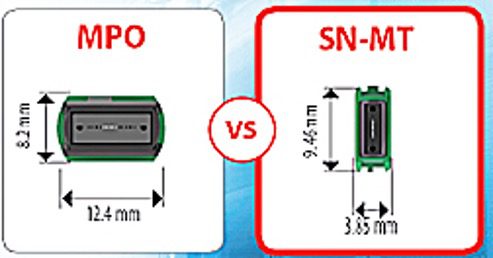OFC Live Returns
The Optical Fiber Communication conference presented a hybrid virtual and in-person event packed with the next generation of optical networking technologies and the connectivity solutions needed to support them.

The Optical Fiber Communication (OFC) conference and exposition celebrated over 45 years of innovation and progress with the 2022 edition. Recognizing much reduced Covid infection rates, conference management provided a hybrid virtual and in-person event. Although in-person attendees were required to be vaccinated and wear a mask at all times, the ability to conduct face-to-face meetings enabled discussion of specific issues and filled an important gap that had been missing from recent virtual-only events.
The number of exhibiting companies at OFC 2022 topped 430 and an estimated 8,000 attendees participated in the virtual and live events. Exhibitors reported that although visitor traffic was reduced compared to pre-pandemic levels, the quality of those that attended more than compensated. Except for a very few unoccupied booths, the San Diego Convention Center floor was filled with the latest and greatest innovations in optical networking technology.
Exhibitors showcased a wide range of devices and services, including enhanced and multi fiber optical cable, a broad range of pluggable transceivers, automated network test equipment, precision component assembly, semiconductor fabrication, copper and optical cable assemblies, modeling, and simulation tools. Global equipment leaders included Juniper Networks, Alibaba Group, Cisco Systems, Arista Networks, Broadcom, Infinera, and MACOM. The fiber optic connector industry was represented by suppliers including Amphenol Communications Solutions, Carlisle Interconnect Technologies, Glenair, Samtec, Fujitsu, Senko, US Conec, and Corning. Molex, HUBER+SUHNER, Sumitomo, and 3M chose to participate via private meeting rooms on the exposition floor.
In addition to the exposition, hundreds of demonstrations, plenary sessions, workshops, panel discussions, and short courses explored the most current advances in optical components, silicon photonics, data transmission protocols, and network test methods. Hot topics included the impact of Industry 4.0, artificial intelligence, quantum computing, coherent communications, advanced fiber optic cables, optical network simulation, and the impact of 5G and 6G. Evolving optical packaging techniques, including near-package and co-packaged optics to support the next several generations of high-bandwidth switches, was a major topic of debate.
Several themes emerged from the exhibits and technical sessions, including:
The industry is being driven by the anticipation of near-future generations of switch technology beyond the current 25.6 Tb/s bandwidth. Roadmaps indicate that 51.2 Tb and 102.4 Tb switches are on the way, which will challenge current system packaging technology based on pluggable optical modules.
Much debate surrounds the ability to continue use of pluggables that pose power consumption as well as faceplate I/O density issues using QSFP-DD or OSFP transceivers. One potential solution which was actively discussed at OFC is the development of near-package optics (NPO) and co-packaged optics (CPO). Rather than locating the electro-optic conversion process in an external pluggable module, NPO and CPO move these functions close to (NPO) or on (CPO) a switch substrate. By doing this, the electrical channel length is minimized, reducing power consumption, and the I/O panel can be populated with small profile optical feed-through connectors. It was obvious from the degree of interest that serious investments in NPO and CPO technology are being made in preparation of supporting next-generation optical networks. The recent OIF framework implementation agreement for a standardized 3.2T module and pluggable external laser created a starting point to accelerate development of practical CPO technology.
The increasing rate of system power consumption is at an unsustainable level, making power efficiency a key criterion at every level of new equipment design. The stated objective for new design is improved performance using the current power envelope.
Open standards are being generated by an expanding array of organizations, including MSAs, and is one aspect of the trend toward disaggregation of system components.

Demonstrations of multi-vendor equipment at the Ethernet Alliance and OIF booths proved interoperability of Open ZR standards. Multiple examples of collaboration were also evident among several equipment manufacturers. The OpenROADM booth was another example of how this trend is playing out.
Coherent optical transmission is being deployed in metro data center networks and is being considered in shorter applications inside the data center. The advantages of much higher data capacity per fiber makes it an attractive alternative to laying more fiber. Falling prices due to higher volume production is also aiding this transition.
400 Gb Ethernet transceivers are now being deployed in volume. 800 Gb Ethernet transceivers are either in demonstration, sampling, or limited production, depending on the supplier. 1.6 Tb Ethernet is the subject of intense investigation.
Component suppliers are filling gaps in their product offerings with multiple interconnect options to provide system designers an array of solutions that can closely match application specific requirements. These include:
- Direct attach passive copper cables that vary in length by bandwidth.
- Active copper cables with improved reach using retimers or linear equalizers.
- Active optical cables that extend the reach of high-performance copper cables
- SFP, QSFP, QSFP-DD, and OSFP pluggable transceivers that offer multiple levels of performance.

Passive copper cables remain the lowest cost option and will continue to be used wherever required performance can be achieved. Active copper cables extend reach and bandwidth, aided by advanced signal conditioning chips from suppliers such as Semtech and Credo.
The physical size comparison between copper and fiber optic alternatives is dramatic. Where bandwidth and reach are the primary requirements, fiber will be the likely choice.
Advances in optical technology were evident in several exhibitor booths. The Consortium for On-Board Optics (COBO) was promoting its co-package optics concept that utilizes an external pluggable laser. A developmental proposal of a multimode waveguide interconnect from Hirose Electric that replaces copper traces with a polymer waveguide laminated into a multilayer PCB was also displayed.

The booths of connector manufacturers included demonstrations of their high-performance copper and fiber optic interfaces.

Amphenol Communications Solutions showed an extensive array of OverPass near ASIC to I/O panel interfaces along with pluggable connectors and cage assemblies.
Amphenol high-speed bulk cables and copper cable assemblies were also on display. The Ardent section of the booth featured high-density compliant pin interposer assemblies designed for high-pin count ASIC devices.

Carlisle Interconnect Technologies featured its LITEflight HD fiber optic cable that is resistant to tight bends and crush forces.

Samtec featured a variety of high-speed cables and connectors, including the company’s FIREFLY® and SI-FLY® approach to CPO packaging.
Another Samtec demonstration showed PCIe 6.0 running at 64 Gt/s through a series of GenZ add-on cards, twinaxial cable, and Flyover cables.

Samtec also displayed 112 Gb PAM4 mid-board to front panel interconnect using new NOVARAY® I/O connectors and Flyover® technology.

The SENKO booth featured several new optical connectors, including Mini MPO plus connectors, which offer lower insertion loss, a removable housing, and easy gender and polarity changes. It is available in 12/24 and 16/32 fiber configurations.

Senko’s SN and CS connectors feature EZ-Flip polarity changes in the field without re-termination.

The new SN-MT 8 and 16 fiber single row connector provides 2.7X greater density compared to standard MPO 16 fiber connectors.
US CONEC showcased its extensive collection of fiber optic interfaces emphasizing features of fiber density, ease of mating, and polarization change.

The MXC, single port blind mate connector utilizes expanded beam technology and is designed for fiber-to-backplane applications where misalignment is an issue.

The DirectConec push-pull connector family includes the new MMC connector, which is a high density, low insertion loss, small form factor interface that offers 3X port density over standard MPO connectors. This connector can support 4, 8, and 16 fiber applications on 250µm pitch.
The last two years have been rough on all industry conferences and trade shows, but the 2022 edition of OFC reflected the resilience of the optical networking community and provided valuable insight on the future direction of photonic networking.
See Bob Hult’s review of the virtual 2021 OFC Conference and revisit his Technology Trends series to learn more about the evolution of high-speed connectivity and other technologies.
Learn more about the Preferred Suppliers mentioned in this article: Amphenol Communication Solutions, Carlisle Interconnect Technologies, and Samtec.
Like this article? Check out our other Wire & Cable and New Technology articles, our Datacom/Telecom Industry articles, and 2022 Article Archives.
Subscribe to our weekly e-newsletters, follow us on LinkedIn, Twitter, and Facebook, and check out our eBook archives for more applicable, expert-informed connectivity content.
- Optics Outpace Copper at OFC 2024 - April 16, 2024
- Digital Lighting Enhances your Theatrical Experience - March 5, 2024
- DesignCon 2024 in Review - February 13, 2024





